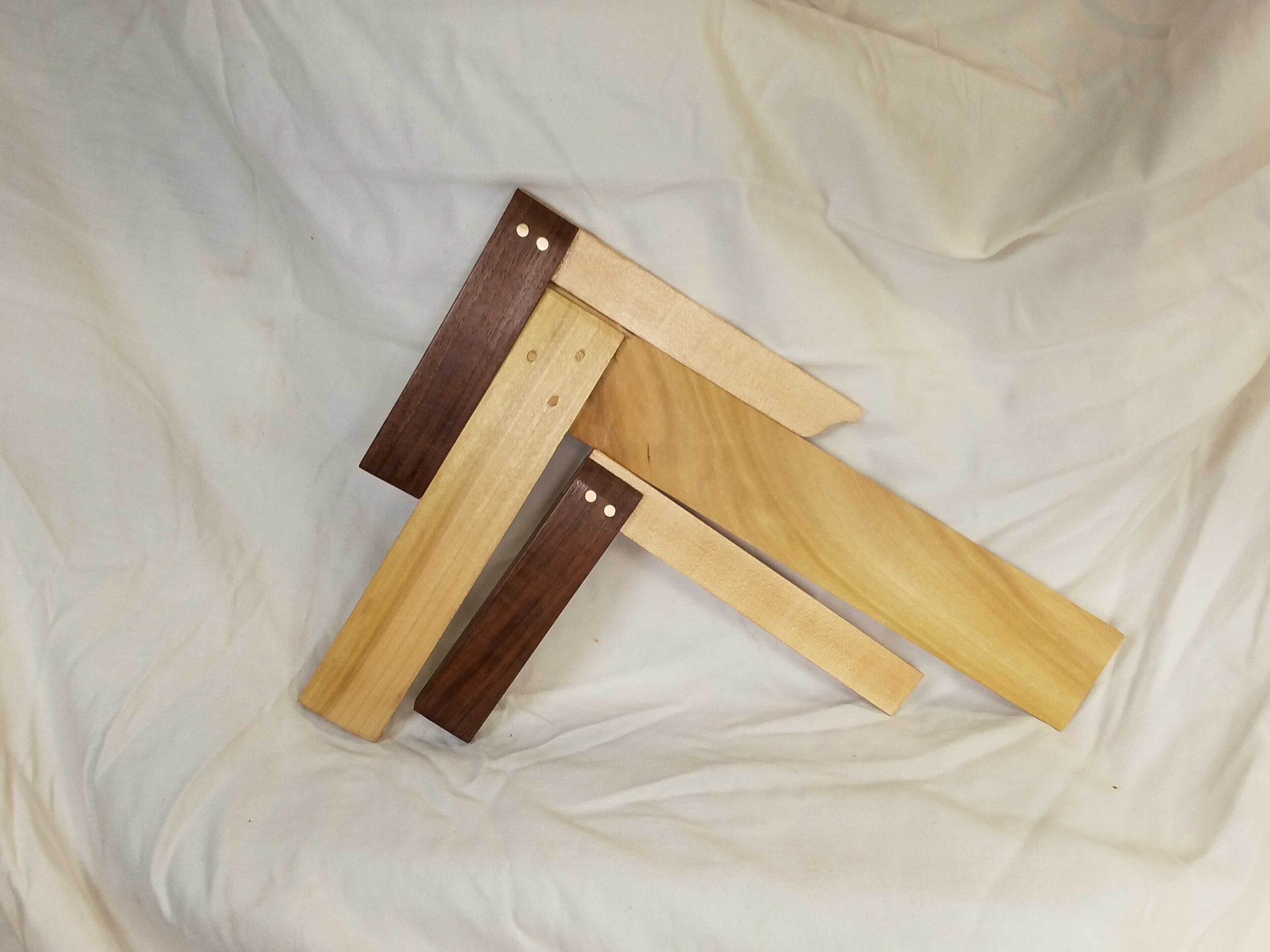Fabrication First: Find the “Mother Tools” and Get Working
I am the cheapest woodworker on YouTube.
I am the guy who bought the cheapest plane on Amazon and used it for months. I am the guy who will help you make an entire set of joinery planes out a handful of chisels.
But all tools have to start somewhere. Give me a blade and a chunk of wood, and I will make you a very decent plane, but only because I own some good tools to make it with. If you want to make a plane, it really helps to own a plane.
This is where things start to get tricky.
Precision has to Start Somewhere.
Tools are like families: trace them back and back, and you find the parent. Last year, I made a whole set of wooden try squares. They came out quite nice and I use them every day. But to get them square, I started with a carpenter’s speed-square, not because it was very good, but because it contained a reliable right angle. Of course, there are other ways to do it, but beginning with a true 90°corner sure made things easier. That cheap little hunk of cast zinc gave birth to my whole family of squares.
With a few irons, I can make a whole set of bench-planes; everything from the jack to the jointer. But it really helps if I can start with one really good smoothing plane.
Now we’re back to planes again.
Some Tools Matter More
In each family of tools (squares, chisels, saws) you find small, medium, and larges ones. It’s easy to think that they come in different sizes to handle different size jobs. You use the big plane on big wood, right?
Actually, no.
Planes and saws come in different sizes to handle different types of jobs. Your massive jointer plane can square the edge of a little plank. Your delicate dovetail saw might cut a joint in a long board. And because these tools have different jobs, we need different things out of them.
Photocredit: Oldhandtools.co.uk
Consider the square. My favorite by far is the 6-inch machinist’s combination square. It cannot be too perfect, and I will spend every cent I can afford on a really good one. But I also have a big wooden try square that I made myself. Its…good. Not perfect, but good enough for squaring up big components where there’s a little room for error. I also own a huge steel carpenter’s square that hangs on the wall for weeks at a time, only coming down to check the corner of a cabinet. Is that thing even square? I’ve honestly never checked.
It’s the same with planes. My jointer needs to be good; it makes flat faces and straight lines. My jack can be any old thing. I don’t even flatten mine.
But my smoothing plane is crucial. It’s not just the plane that makes final surfaces, it also squares small pieces, trims edges and shoots thousandths of an inch of end grain off a shelf edge. This is the plane I use to make other planes.
I accept no compromises.
A Floor But No Ceiling
Before I did woodwork, I studied music and I’m always amazed at what you can spend on instruments. There’s no limit.
Image Left: PRS Guitar. Image Right: 59 Les Paul. Photo Credit: GBase/Guitar.com
A Paul Reed Smith Guitar (which you can pick up at any large music retailer) can run you $4000 or more. A 1959 Gibson Les Paul can fetch upwards of $250,000 dollars. That’s right. A quarter of a million dollars for an electric guitar. And that’s not even the end. Want to see a guitar that costs a million dollars? Just Google it; there are several.
Tools are the same.
Photo Credit: Konrad Sauer
A Sauer and Steiner infill smoother plane will set you back several thousand dollars (and that’s if you can even find one for sale). Konrad Sauer, who hand-makes each one, is both an artist and a precision task-master. People line up to buy his planes, even at four figures a pop. But no one needs one of these masterpieces to do woodwork.
Photo Credit: Grizzly Industrial
Let’s pull back a bit. A Lie Nielsen No. 4 costs $350 and no one disputes their impressive quality and consistency. It’s better than you absolutely need, but you’ll never find it lacking.
Photo Credit: Grizzly Industrial
Far further down line is a plane made by Soba Industries in India. Their offerings are sold by retailers like Grizzly and they’ll set you back a mere $50. For that price, they’re a real value. I own two and they’re quite decent. They work. They plane wood and leave a good surface. But that’s only after you spend hours tweaking and fiddling with them to get them running right. And even then, they’re a stepping stone, a beginner’s tool that will tide you over until you have the luck or the wallet for a vintage Stanley.
At the top end of the tool world, you can spend any amount of money, but at the bottom, there’s a point where the money is just wasted. You cannot buy a functional tool at any price. I know. I’ve done the research.
But somewhere between the dizzying prices of the premium and the gritty depths of the bargain basement, there’s the Floor: the minimum you can spend on a tool that will do you more good than harm. For each type of tool, there’s a model that you can just buy and be done. And when you get it home, you’ll spend more time working wood than futzing with the tool.
There are many woodworks who will tell you to save your pennies, buy these tools and be done with it. And after years of helping woodworkers bootstrap their way through ultra-cheap tools, I’m starting to agree.
Finding the “Mother Tools”
I can find the best value in any family of tools. I could spend months getting together a whole set of “lifetime tools.” But that wouldn’t help. Any list I came up with would still cost too much for most woodworkers. This isn’t the Woodwork for Humans way. We can do better.
At the core of Woodwork for Humans is ingenuity and self-sufficiency. We pursue the craft with minimum consumption. We make our own tools. We make good tools, but we need someplace to start.
All this month, I’ll be looking at spending money on tools that will give you a foundation for the craft. We’re going to look the minimum money that will get you a lifetime tool. But even more importantly, we’re looking for the tools that will let us make the rest of what we need.
These are the Mother Tools.
It’s a simple idea: get a good smoothing plane and you can build a nice jointer. Buy one good backsaw and you can build a frame-saw for your ripping and a turning saw for your curves. The money you plunk down on each of your Mother Tools will also trickle down to the tools you can make with it. The value will spread over your whole tool chest.
And I’m not talking about a pile of expensive tools. I’m talking about 4 or 5 high quality tools to form the center of your tool chest. Some of them aren’t even expensive. I’ve found a combination square that’s good enough to be a Mother Tool and it’s only $10. I’ll be reviewing it this month.
And I’m the man for the job. I’ve used the garbage. I’ve fixed it up and suffered through it and actually made furniture with it. But I’m also a collector. I own a lot of tools and you’ve never seen most of them. So I know when something really sings. I know about models and features that some people have never heard of.
As our work moves forward, I’m going to ask you to do something new: spend a little bit more money. But our journey is like investing: the money we lay down now will come back to us over and over throughout the years.
And while we’re sorting our way through the few new tools we might need to buy, there’s one tool that most of us should always make: the mallet. Commercial ones are either way too expensive or just junk. A few months ago, I built a fantastic mallet that’s comfortable, effective, and will last for decades. You can make this outstanding mallet with basic tools and a few scraps, and it’s a real skill-builder. Since we’re all sheltering at home anyway, why not make some tools. For the next two weeks, take 30% off my traditional mallet plans with the code MALLET30. You can find them here.







